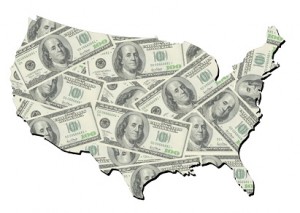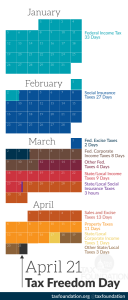by | ARTICLES, BUSINESS, ECONOMY, FREEDOM, GOVERNMENT, OBAMA, TAXES

This is a tad worrisome:
Nonfarm business sector labor productivity decreased at a 3.2 percent annual rate during the first quarter of 2014, the U.S. Bureau of Labor Statistics reported today, as hours increased 2.2 percent and output decreased 1.1 percent. (All quarterly percent changes in this release are seasonally adjusted annual rates.) The decrease in productivity was the largest since the first quarter of 2008 (-3.9 percent).
And this:
In the first quarter of 2014, nonfarm business productivity fell 3.2 percent, a greater decline than was reported in the preliminary estimate. The revised figure reflects a 1.4 percentage point downward revision to output and a 0.2 percentage point upward revision to hours.
You can read the whole report here
No one else seems to be reporting on the revised numbers, which mirror that of the 1st quarter of 2008 (-3.9).
Couple this with the report last week that the “economy in the U.S. contracted for the first time in three years from January through March as companies added to inventories at a slower pace and curtailed investment”.
It will be interesting to see what the unemployment numbers show on Friday.
Friday update: Unemployment stays flat
by | ARTICLES, ECONOMY, FREEDOM, GOVERNMENT, OBAMA, POLITICS, TAXES

Diana Furchtgott-Roth wrote an article this past week outlining the economic impact of Obama’s newest regulations. Obama has decided through Executive Order to institute environmental regulations similar to those in the failed “cap-and-trade” legislation from a few years ago. But Obama will now go a step further than just the regulation of power plants; regulations will include regional emissions.
Regulation is stifling. It creates more barriers for American businesses which drives up costs for consumers. Businesses which are abroad are not subject to such regulation, which means they will often be able to charge less for products than American ones. With the economy at such a sluggish pace right now, of course consumers will purchase the lowest price. With higher costs to run the business, as well as drop in demand for product, employees will face the risk of losing jobs as a cost-saving measure for their employer.
Some lawmakers are waking up to the economic impact over-regulation has on our industries. Several legislators introduced a bipartisan in 2011 aiming to reduce regulatory burdens in particular agricultural endeavors. According to records, “this legislation passed the U.S. House of Representatives on March 31, 2011 as H.R. 872, The Reducing Regulatory Burdens Act of 2011. Additionally, it advanced out of the U.S. Senate Committee on Agriculture, Nutrition, and Forestry, but the full Senate failed to consider it during the last Congress”. It is now known as H.R.935, “The Reducing Regulatory Burdens Act of 2013”. Yesterday, on June 2, it was placed on the Union Calendar, which means it has not been defeated in Committee. Such legislation is a starting point for raising awareness of the destructive nature of burdensome regulation.
Back to Obama’s new Executive Order environmental rules. Furchtgott-Roth summed up her article nicely when she wrote,”For those concerned about economic growth, poverty, and inequality, cap-and-trade makes no sense, either nationally or regionally. Our air is getting cleaner, and will continue to do so for the foreseeable future as new capital replaces old. Cap-and-trade did not pass a Democratic Congress in 2010, and Mr. Obama should not impose it on a regional basis through regulation”.
by | ARTICLES, BUSINESS, ECONOMY, OBAMA, OBAMACARE, TAXES

The NYT reported that the IRS made yet another law clarification this past week:
“Many employers — some that now offer coverage and some that do not — had concluded that it would be cheaper to provide each employee with a lump sum of money to buy insurance on an exchange, instead of providing coverage directly.
But the Obama administration raised objections, contained in an authoritative question-and-answer document released by the Internal Revenue Service, in consultation with other agencies.
The health law, known as the Affordable Care Act, builds on the current system of employer-based health insurance. The administration, like many in Congress, wants employers to continue to provide coverage to workers and their families”.
However, it seems that the real issue is less about continuing coverage and more about getting as much tax revenue for the government as possible:
Christopher E. Condeluci, a former tax and benefits counsel to the Senate Finance Committee, said the ruling was significant because it made clear that “an employee cannot use tax-free contributions from an employer to purchase an insurance policy sold in the individual health insurance market, inside or outside an exchange.”
If an employer wants to help employees buy insurance on their own, Mr. Condeluci said, it can give them higher pay, in the form of taxable wages. But in such cases, he said, the employer and the employee would owe payroll taxes on those wages, and the change could be viewed by workers as reducing a valuable benefit”.
The ruling comes as the IRS seeks to finish establishing the plans and programs for employer coverage that starts in 2015.
by | ARTICLES, ECONOMY, FREEDOM, OBAMA, POLITICS, TAXES
The Pease Amendment came into play for high income taxpayers this year once again, after a bit of a hiatus. The Pease Amendment was passed as part of the Omnibus Budget Reconciliation Act of 1990, and named after Congressman Donald Pease, who introduced it. This rule provided that if your adjusted gross income (AGI) passed a particular threshold, then some deductions would be reduced on your taxes — thereby curbing your ability to limit your tax liability.
This rule has the effect of increases tax rates for those individuals by 1.2% — therefore a tax rate that was 39.6% became 40.8%. The way it was done is patently criminal because it uses the tax system to incorporate a complicated formula to hide the fact you are raising tax rates. There is no rational or logical reason for a formula like that to be used unless its intent was to deceive.
Acknowledging the irrationality of the Pease Amendment, Congress slowly scaled it back and then eliminated by 2010 after the Economic Growth and Tax Relief Reconciliation Act of 2001. During 2010 session, Congress passed the 2010 Tax Relief Act which extended the elimination of the Pease Amendment, but only through 2012.
By that time, it was understood that the tax reductions of 2001, including across-the-board rate reductions, the Pease Amendment and Personal Exemption Phaseouts (PEP) would all be gone forever. And yet, Congress declined to extend the Pease Amendment elimination further past 2012 which meant that 2013 saw a return to the previous Pease Amendment rules that existed before 2001.
Also during that time in 2012, Obama insisted as a revenue-raising measure that the rates in the Bush tax cuts be reinstated for the high income earners in 2012. This is a simple, straight-forward tax hike. But in an action that can only be considered mean spirited, and counter to any attempt to simplify the tax laws, Obama personally insisted that both the Pease Amendment and the similarly convoluted Personal Exemption Phaseouts (PEP) be reinstated for high network individuals. Their reintroduction into the tax code by Congress is unconscionable.
The tricky thing about the Pease Amendment is that it actually has very little to do with deductions, because the trigger to implement it is based on earned income thresholds. Eliminating deductions based on income — which then affects the amount of increases tax paid — is underhanded.
Coming on the heels of the actual margin rate increase in 2012 when rates for highest earners reverted to the 39.6% rate of the Clinton years, many taxpayers found themselves with even higher tax bills in 2013 without an actual tax increase due to re implementation of the Pease Amendment. The result of the rule ensured that wealthy taxpayers were squeezed just a little bit more for their “fair share” — now nearly 41% on income tax alone.
The Pease Amendment carefully obfuscates the net effect of raising taxes without having to actually do so. Perhaps the most interesting thing about the amendment is that Pease’s only claim to fame as an eight-term Congressman is that he is responsible for writing a tax rule that tricks people into paying more taxes than they believed they were paying.
by | ARTICLES, ECONOMY, GOVERNMENT, OBAMA, TAXES

Recently, the WSJ had an article drawing attention to Obama’s changes made to the student loan system for higher education. The article, while it raised good points, did not go far enough to explain the detriment to our economy that his program is causing.
President Obama is intentionally undermining people’s successes — and our nation’s success — by encouraging large amounts of graduates to go into the government and the non-profit sectors and then subsequently forgiving student loan debt. This practice is both a) incompetent as a matter of economics and b) devious as a matter of policy.
Indisputably, the driver of economic growth in our country’s history has been the free market. By having the forces of supply and demand set prices for different things and wage levels for types and quality of labor, people were able to make logical choices of what businesses to go into, and what jobs to study and train for. The higher paying jobs were those most productive to society and had the logical effect of encouraging economic growth. Individuals could match their skill set with their desire to earn money to find their best employment, and would be maximizing the country’s economic growth as a by-product.
While non-profits have in important place in our society, they do not play an important role in actually driving our economy, which is something we desperately need right now. Discouraging economic growth, and paying a high price to do so, is certainly not smart.
Likewise, the other sector in which Obama is encouraging students to find work is the government. In the past, the public sector may not have paid as much as the private sector. Today, however, the public sector is better paid with more generous benefits, making it a very lucrative career path. How then, can Obama justify student loan forgiveness for government workers who will actually earn more than their private sector peers, who are also the ones who have to fulfill their contractual obligations to pay back their student loans?
One of the provisions of student loan reform is that Obama made certain student loans “non-taxable” if the loan is forgiven, while keeping other loans taxable as income received. This inconsistency creates confusion regarding which loans have what kind of classification.
In general, if someone forgives a debt, like a credit card company, if you racked up $10,000 in debt and settled to pay off $5,000, the IRS considers that you received $5,000 of income from the loan forgiveness; you will receive a 1099 for it, and will be expected to report it as income on your taxes. On the other hand, if you work in a qualifying field in exchange for income and also student loan forgiveness, you have a scenario that is truly the very definition of income — and yet Obama has given a free pass to some loans by making their loan forgiveness also non-taxable.
Obama is essentially picking winners and losers in particular industries through the student loan programs and masking it under student loan forgiveness and “non-taxable” categories. This is underhanded policy.
This mindset is one that suggests to and encourages students to take large amounts of student loans and then go into the sectors where their loan can be forgiven — not into the sectors where they would be most productive, and therefore most likely to earn enough to pay it back. It’s like saying to the students, “Here’s a way to not pay back your loans!”. Frankly, that’s criminal. And it fundamentally subverts the basis principles of logic and economics. Also, I can tell you as an accountant, the numbers for Obama’s student loan policy simply don’t work.
For example, if someone borrows $30,000 a year for 4 years for a degree, that is $120,000 of student loan debt. The debt carries an interest rate of at least 6%. The Obama repayment plans offer an option that allows borrowers to pay 10% (it used to be 15%) of what they earn, and if not fully paid back by the end of ten years, any balance is forgiven.. So for instance, if a new graduate lands a job that pays a generous $50,000/year, he/she would pay back $5,000/year. With interest of at least $7,200 ($120,000 x 6%) which likely does not even cover the interest on the original $120,000 loan.
There is almost no way a borrower can begin to pay back anything on their loan, and by the time they actually can make a dent, the additional interest accrued would have ballooned the total loan amount to at least $150,000. This is financially crippling for a young person.
In essence, what Obama is doing to win over the young people voting bloc is simply telling them another huge lie. He is suggesting they take out loans on which they will never be able to pay back the principal. The numbers do not work. It’s a terrible gamble; no student can pay off the loan in any rational way from any jobs in the fields they are encouraged to enter to in with the incentives offered to by the Obama Administration.
The costs for “Pay As You Earn” have ballooned from $1.7 billion in 2010 to $3.5 billion in 2013 to an estimated $7.6 billion for 2014.
“This might seem like a windfall for the students, but the only clear winners are the universities that are the ultimate recipients of the taxpayer money. While the students may technically get the freebie, the impressionable youngsters, who likely have little or no wealth, are being given an enormous financial incentive to pursue careers in government or at low-paying nonprofits.
The consequences for our economy are no less tragic than for the individual borrowers. They are being driven away from the path down which their natural ambition and talent might have taken them. President Obama keeps talking about reducing income equality. So why does he keep paying young people not to pursue higher incomes?”
The real impact of this higher education reform is that the government is now encouraging people to borrow substantially for their education, while simultaneously providing an avenue for students to avoid paying back the funds — leaving the taxpayer on the hook, a deficit in freefall, and an economy in stagnation.
by | ARTICLES, BLOG, FREEDOM, GOVERNMENT, HYPOCRISY, POLITICS, TAXES

Many people this year are startled to find that the IRS is holding some or all of the portions of their tax return as a form of payment for old debt. Many so called debts are decades-old and often the debt is not even the debt of the taxpayer being targeted.
How did this happen? The first part of the process began in 2008, when Congress passed HR6124, The “Food, Conservation, and Energy Act 0f 2008”, commonly known as the “Farm Bill”. On page 594-594 of the 662 page document, Section 14219 reads. “Elimination of statute of limitations applicable to collection of debt by administrative offset”.
(a) ELIMINATION.—Section 3716(e) of title 31, United States
Code, is amended to read as follows: ‘‘(e)(1) Notwithstanding any other provision of law, regulation,
or administrative limitation, no limitation on the period within which an offset may be initiated or taken pursuant to this section shall be effective. (2) This section does not apply when a statute explicitly prohibits using administrative offset of setoff to collect the claim or type of claim involved.” (b) APPLICATION OF AMENDMENT — The amendment made by subsection (a) shall apply to any debt outstanding on or after the date of the enactment of this Act.
As a result of this legislation, the Department of the Treasury issued 74 FR 68537: “OFFSET OF TAX REFUND PAYMENTS TO COLLECT PAST-DUE, LEGALLY ENFORCEABLE NONTAX DEBT” on December 28, 2009. The Department of the Treasury, Financial Management Service made changes to it how it dealt with non-tax debts owed by taxpayers. This rule allowed the “ offset of Federal tax refunds irrespective of the amount of time the debt has been outstanding”.
I. Background
“The Food, Conservation and Energy Act of 2008, Public Law 110–234,
Section 14219, 22 Stat. 923 (2008) (‘‘the Act’’) amended the Debt Collection Act
of 1982 (as amended by the Debt Collection Improvement Act of 1996) to
authorize the offset of Federal nontax payments (for example, contract and salary payments) to collect delinquent Federal debt without regard to the amount of time the debt has been delinquent. Prior to this change, nontax payments could be offset only to collect
debt that was delinquent for a period of less than ten years. There is no similar time limitation in the statutes authorizing offset of Federal tax refund payments to collect Federal
nontax debts (see 26 U.S.C. 6402(a) and 31 U.S.C. 3720A). However, Treasury had imposed a time limitation on collection of debts by tax refund offset in order to create uniformity in the way that it offset payments. Now that the ten-year limitation has been eliminated for the offset of nontax payments, the rationale for including a ten-year limitation for the offset of tax refund payments no longer applies.
Therefore, on June 11, 2009, Treasury issued a notice of proposed rulemaking proposing to remove the limitations period by explicitly stating that no time limitation shall apply. See 74 FR 27730. The proposed rule explained that by removing the time limitation, all Federal nontax debts, including debts that were ineligible for collection by offset prior to the removal of the limitations period, may now be collected by tax refund offset. Additionally, to avoid any undue hardship, Treasury proposed the addition of a notice requirement applicable to debts that were previously ineligible for collection by offset because they had been outstanding for more than ten years. For such debts, creditor agencies must certify to FMS that a notice of intent to offset was sent to the debtor after the debt became ten years delinquent. This notice of intent to offset is meant to alert the debtor that any debt the taxpayer owes to the United States may now be collected by offset, even if it is greater than ten years delinquent. It also allows the debtor additional opportunities to dispute the debt, enter into a repayment agreement or otherwise avoid offset. This requirement will apply even in a case where notice was sent prior to the debt becoming ten years old. This requirement applies only with respect to debts that were previously ineligible for collection by offset because of the previous time limitation. Accordingly, it does not apply with respect to debts that could be collected by offset without regard to any time limitation prior to this regulatory change—for example, Department of Education student loan debts.”
The ramifications of this rule change has been far reaching. One agency, the IRS, has used it to justify going after old debts by holding tax refunds. This is a growing problem, because the agency has begun going after relatives of the phantom debt, not the debt-holder themselves.
According to the Treasury rule, “For such debts, creditor agencies must certify to FMS
that a notice of intent to offset was sent to the debtor after the debt became ten years delinquent. This notice of intent to offset is meant to alert the debtor that any debt the taxpayer owes to the United States may now be collected by offset, even if it is greater than ten years delinquent”.
The rule does not state “relative of the debtor”. In several instances this year alone, the targeted person was a relative of the debt-holder, not the debt-holder themselves, and every one of them stated they received no notice or advance warning from the IRS before the IRS decided to withhold their refund. The IRS has no right to do so.
There exists a process called “transferee liability” where the IRS can go after the debts of a relative. It is a high burden process and is not done easily. Such a scenario might be if a person died with $100,000 in a bank account, which was bequeathed to a child. Then later, it was revealed that the original account holder owed the IRS, which really should have been discovered by the person doing the estate process, and thus the money received by bequeathment could be considered as being received under false pretenses. The IRS in this situation could make a case, under “transferee liability”, that it has a right to go after the relative for that money.
Obviously, this above scenario is much different than resurrecting decades-old debt via an obscure provision in a 662 page bill. Those affected by it should demand proof of debt as well as argue that the debt is not theirs. However, in the cases where the IRS merely held the tax refund, the “debtor” did not receive due process and is at the mercy of trying to deal with a convoluted, poorly run government agency. Most people do not have the time or means to fight back. This action taken by the IRS is legal plunder, plain and simple.
by | ARTICLES, ECONOMY, OBAMA, POLITICS, TAXES

It’s the spending, stupid.
CNS News reported today that “Federal tax revenues continue to run at a record pace in fiscal 2014, as the federal government’s total receipts for the fiscal year closed April at $1,735,030,000,000, according to the Monthly Treasury Statement.
Despite this record revenue, the federal government still ran a deficit of $306.411 billion in the first seven months of the fiscal year, which began on Oct. 1, 2013 and will end on Sept. 30, 2014”.
The White House Office of Management and Budget has put out the following estimates for 2014: revenues will be $3.001721 trillion in taxes with spending estimated to be $3.650526 trillion — thereby running a deficit of $648.805 billion.
The problem isn’t lack of taxes. “The single largest source for the federal government’s record tax receipts in the first seven months of FY 2014 was the individual income tax, which brought the Treasury $823.079 billion”
The problem is egregious spending.
by | ARTICLES, ECONOMY, OBAMA, OBAMACARE, TAXES
Americans for Tax Reform (ATR) has done an analysis of taxes that Obama has proposed since taking office, by looking the Obama administration budgets for FY2010 – FY2015.
“The 442 total proposed tax increases does not include the 20 tax increases Obama signed into law as part of Obamacare.
Here’s a breakdown of potential taxes by by budget year:
“-79 tax increases for FY 2010
-52 tax increases for FY 2011
-47 tax increases for FY 2012
-34 tax increases for FY 2013
-137 tax increases for FY 2014
-93 tax increases for FY 2015
“History tells us what Obama was able to do. This list reminds us of what Obama wanted to do,”
by | ARTICLES, ECONOMY, FREEDOM, TAXES
The Tax Foundation releases an annual “Tax Freedom Day” report, which calculates “the day when the nation as a whole has earned enough money to pay its total tax bill for year”.
This is done by looking at federal budget projections, data from the U.S. Census and the Bureau of Economic Analysis, and projections of state & local taxes. Then, all the federal, state, and local taxes are divided by the country’s income.
This year, Tax Freedom day is April 21st, 3 days later than last year. The Tax Foundation cites sluggish economic growth and recovery.
Here’s a neat graphic from the Tax Foundation, which shows the breakdown:

The Tax Foundation calculates that “in 2014, Americans will pay $3.0 trillion in federal taxes and $1.5 trillion in state taxes, for a total tax bill of $4.5 trillion, or 30.2 percent of income”.
You can also visit the site to see how your state factors in, or what the Tax Freedom date is if you include federal borrowing.
by | ARTICLES, ELECTIONS, FREEDOM, GOVERNMENT, OBAMA, TAXES
Last week, the Commissioner of Internal Revenue Service, John Koskinen, spoke to the National Press Club on a variety of matters. One of the items he discussed was the proposed regulation changes to 501c4s.
As I mentioned earlier, the citizen commentary on this matter was unprecedented. As such, the IRS concluded they could not review it all in a timely matter for this year. However, he did not say that the matter was closed — only delayed:
“Another recommendation by the IG was that the Treasury Department and the IRS should provide clearer guidance on how to assess the permissibility of 501(c)(4) social welfare organizations’ activities. So last November, Treasury and the IRS issued proposed regulations that are designed to clarify the extent to which a 501(c)(4) organization can engage in political activity without endangering its tax-exempt status.
While I was not involved in the issuance of this draft proposal, because it happened before I was confirmed as Commissioner, I believe it is extremely important to make this area of regulation as clear as possible. Not only does that help the IRS properly enforce the law, but clearer regulations will also give a better roadmap to applicants, and will help those that already have 501(c)(4) status properly administer their organizations without unnecessary fears of losing their tax-exempt status.
During the comment period, which ended in February, we received more than 150,000 comments. That’s a record for an IRS rulemaking comment period. In fact, if you take all the comments on all Treasury and IRS draft proposals over the last seven years and double that number, you come close to the number of comments we are now beginning to review and analyze. It’s going to take us a while to sort through all those comments, hold a public hearing, possibly repropose a draft regulation and get more public comments. This means that it is unlikely we will be able to complete this process before the end of the year.”
Therefore, the IRS will continue to ponder the matter and revisit it — likely during another important election cycle. It is imperative to keep an eye on this, as the changes are onerous and unnecessary for the operation of 501c4s to educate and advocate.






